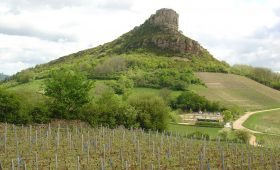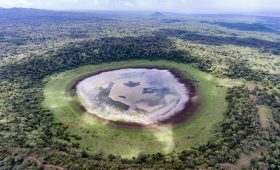Geography and Natural Features
The Trigrad Gorge (in Bulgarian: Триградско ждрело) is a spectacular canyon carved into the marble of the Rhodope Mountains, located in southern Bulgaria.
The Trigrad River carves its way through the gorge, eventually disappearing into the Devil’s Throat Cave and reemerging 530 meters below as a waterfall. This river ultimately joins the Byunovska River. The gorge’s western and eastern walls rise to 300 meters and 350 meters, respectively. The width narrows from 300 meters to a mere 100 meters as you head north. Located 1.2 km from the village of Trigrad, the gorge sits at an altitude of 1,450 meters and stretches over 7 kilometers, with the main section spanning 2 to 3 kilometers.
Wildlife and Flora
Trigrad Gorge is a prime location for birdwatching, particularly for spotting the elusive Wallcreeper. The area’s diverse habitats support a variety of bird species. The gorge is also home to unique flora, including the endemic Rhodope haberlea, and a range of butterfly species, adding to its ecological richness.
Getting There
To reach Trigrad Gorge, fly into Sofia International Airport, the nearest major hub with international connections. Renting a car from Sofia is the most efficient way to reach the gorge, with a drive time of about 3-4 hours through scenic Bulgarian landscapes. Alternatively, buses are available, though they require more time and patience due to longer travel durations.
When to Visit
The gorge is accessible year-round, but the best time to visit is from April to September. During these months, the weather is mild, ideal for outdoor activities. Spring offers vibrant wildflowers and lush greenery, while summer provides comfortable temperatures for hiking. Note that summer can be busier, so visiting in spring or fall might offer a quieter experience.
Exploring Trigrad Gorge
Trigrad Gorge is a geological wonder, sculpted by the Trigradska River through limestone cliffs over millions of years. A boat ride through the narrowest part of the gorge offers an immersive experience with towering cliffs and dramatic rock formations.
The Devil’s Throat Cave is a must-visit. Known for its vast size, it features the highest underground waterfall in the Balkans. The cave’s stalactites and stalagmites create an otherworldly atmosphere.
For adventure seekers, rock climbing is available, with routes catering to various skill levels. Climbers are rewarded with breathtaking views from the top.
Local Transportation
Once at Trigrad Gorge, exploring on foot is recommended. The area is compact, and many attractions are within walking distance. Wear comfortable shoes for uphill walks. For visiting nearby villages or distant attractions, renting a car or hiring a local taxi is advisable, as public transportation is limited. Having your own vehicle offers flexibility to explore at your own pace.
Accommodation
Despite its remote location, Trigrad Gorge offers a range of accommodations. Traditional Bulgarian guesthouses provide cozy stays with warm hospitality and local cuisine. These guesthouses often include comfortable rooms and home-cooked meals, offering a taste of local culture.
For more luxurious options, several hotels and resorts in the area offer stunning views of the surrounding mountains and valleys. These accommodations may include amenities like spa facilities, swimming pools, and on-site dining.




